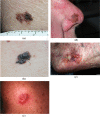Recognising Skin Cancer in Primary Care
- PMID: 31734824
- PMCID: PMC6969010
- DOI: 10.1007/s12325-019-01130-1
Recognising Skin Cancer in Primary Care
Abstract
Skin cancer, including melanoma, basal cell carcinoma and cutaneous squamous cell carcinoma, has one of the highest global incidences of any form of cancer. In 2016 more than 16,000 people were diagnosed with melanoma in the UK. Over the last decade the incidence of melanoma has increased by 50% in the UK, and about one in ten melanomas are diagnosed at a late stage. Among the keratinocyte carcinomas (previously known as non-melanoma skin cancers), basal cell carcinoma is the most common cancer amongst Caucasian populations. The main risk factor for all skin cancer is exposure to ultraviolet radiation-more than 80% are considered preventable. Primary care clinicians have a vital role to play in detecting and managing patients with skin lesions suspected to be skin cancer, as timely diagnosis and treatment can improve patient outcomes, particularly for melanoma. However, detecting skin cancer can be challenging, as common non-malignant skin lesions such as seborrhoeic keratoses share features with less common skin cancers. Given that more than 80% of skin cancers are attributed to ultraviolet (UV) exposure, primary care clinicians can also play an important role in skin cancer prevention. This article is one of a series discussing cancer prevention and detection in primary care. Here we focus on the most common types of skin cancer: melanoma, squamous cell carcinoma and basal cell carcinoma. We describe the main risk factors and prevention advice. We summarise key guidance on the symptoms and signs of skin cancers and their management, including their initial assessment and referral. In addition, we review emerging technologies and diagnostic aids which may become available for use in primary care in the near future, to aid the triage of suspicious skin lesions.
Keywords: Basal cell carcinoma; Early diagnosis; Melanoma; Primary care; Skin cancer; Squamous cell carcinoma.
Figures







References
-
- Ferlay J, Colombet M, Soerjomataram I, et al. Cancer incidence and mortality patterns in Europe: estimates for 40 countries and 25 major cancers in 2018. Eur J Cancer. 2018;103:356–387. - PubMed
-
- Cancer Research UK About melanoma. https://www.cancerresearchuk.org/about-cancer/melanoma/about. Accessed 30 Aug 2019.
-
- Garbe C, Peris K, Hauschild A, et al. Diagnosis and treatment of melanoma. European consensus-based interdisciplinary guideline—update 2016. Eur J Cancer. 2016;63:201–217. - PubMed
-
- Karimkhani C, Boyers LN, Dellavalle RP, Weinstock MA. It’s time for “keratinocyte carcinoma” to replace the term “nonmelanoma skin cancer”. J Am Acad Dermatol. 2015;72(1):186–187. - PubMed
MeSH terms
Associated data
Grants and funding
LinkOut - more resources
Full Text Sources
Medical

